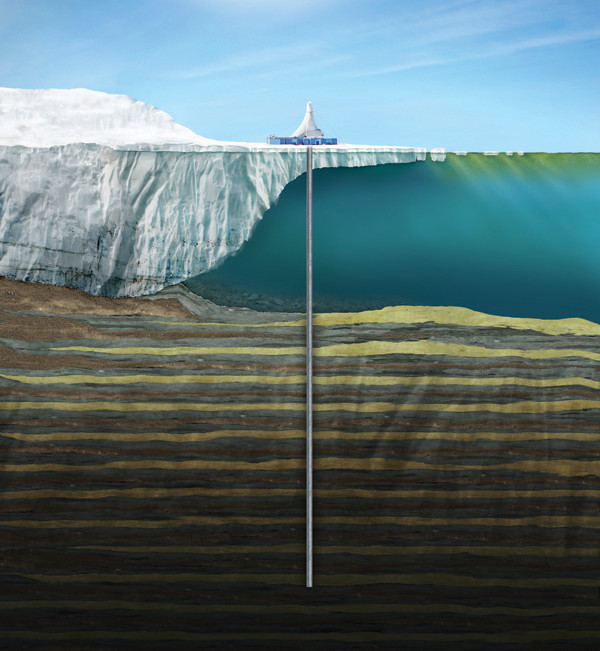
by Jay R. Thompson Friday, August 24, 2012

Scanning electron micrograph of a modern southern beech pollen grain that resembles pollen from the last stunted trees on Antarctica, which disappeared in the Late Miocene. Sophie Warny and Kate Griener, LSU

Rendering of drilling operations during the ANDRILL 2 campaign in Southern McMurdo Sound, Antarctica, from October through December 2007. University of Nebraska-Lincoln
Antarctic ice sheets can be unforgiving field sites for scientists looking for fossils, as the ice grinds and pulverizes signs of previous life. The adjacent ocean sediments, however, are a good hiding place for microscopic fossils from plants — pollen and leaf waxes that provide clues to ancient temperatures. Scientists have now retrieved samples of pollen and leaf wax from 15.5-million- to 20-million-year-old sediments that indicate Antarctica not only received more rain during the Middle Miocene than previously thought, but was also home to trees, albeit stubby ones. The discovery implies that, contrary to previous thinking, the continent has experienced warm periods since the onset of the most recent glaciation.
Sarah Feakins, a paleoclimatologist and organic geochemist at the University of Southern California who led the recent study published in Nature Geoscience, says that a large ice sheet began to develop on Antarctica 34 million years ago. But scientists have thought that for the most part, the continent has been pretty cold since. Then Sophie Warny, a palynologist at Louisiana State University and co-author of the study, reported in a previous study that she’d found high levels of pollen in Middle Miocene ocean sediment collected near Antarctica. “We were surprised by the species that were there and how much pollen was there,” Feakins says.
To estimate Middle Miocene temperatures, precipitation and vegetation in the area now covered by the Ross Ice Shelf, Feakins and her team turned to sediment core samples taken from the ANDRILL 2 Antarctic geological drilling project in 2007. The ANDRILL rig drilled through the Ross Ice Shelf, passed through about 400 meters of water, and then penetrated more than a kilometer of sediment. Feakins and her team looked for leaf wax and pollen in sediments taken from between 144 and 1,100 meters below the seafloor — depths that date between 12 million and 20 million years ago.
The team found that concentrations of both pollen and wax spike at 16.4 million and 15.7 million years ago, representing two brief warming spells, each of which lasted less than 30,000 years. In addition, the researchers determined that the leaf wax and pollen didn’t blow in from elsewhere. It came from two species of trees — podocarp conifer and southern beech — that grew on the margins of Antarctica and don’t spread pollen widely, they reported. If the pollen were blowing in from elsewhere, they would expect to find evidence of more species. “If [pollen and wax] were being transported from the Andes and New Zealand, we would expect to find them everywhere [in the core],” Feakins says.
Feakins used a mass spectrometer to determine the ratio of hydrogen to deuterium in wax molecules, which showed how warm Antarctica was during the temperature spikes. Together with model experiments by co-author Jung-Eun Lee, a climate modeler at NASA’s Jet Propulsion Laboratory at Caltech, the results suggest that temperatures at the Ross Ice Shelf were 7 degrees Celsius in the summer, whereas the same location reaches about minus 4 degrees Celsius in summer today. Conditions were similar to what parts of Chile experience today, Feakins says. Previous studies have suggested that global average temperature during the Middle Miocene was about 3 degrees Celsius warmer than today, she says, but no one had previously estimated temperatures for this location. For temperatures to be 11 degrees Celsius warmer than today was surprising for the Middle Miocene, Feakins says, “but not completely unexpected because we expect ‘polar amplification.’” That is, when the Earth warms as a whole, polar regions warm disproportionately more than lower latitudes.
“This result is important because it focuses our attention on how the hydrological system can be impacted during global warming,” says Mark Pagani, a Yale University geochemist not involved in the study, adding that the finding reinforces what scientists in other fields are finding. The data from this and other studies of the past 20 million years “worry us because it appears that Earth’s climate and hydrological systems are very sensitive,” Pagani says. Today’s atmospheric carbon dioxide levels — 396 parts per million — are creeping up toward levels similar to those at the time of the Middle Miocene warming, which are thought to have been 400 to 600 parts per million. If trees can grow on Antarctica with carbon dioxide levels not much higher than today’s, he says, it suggests that small changes in carbon dioxide can lead to big changes in climate.
As for the trees, Feakins says, they may have been shin-height or taller — and likely stunted, not a great big forest. “We don’t have fossil trees, so we have to be careful” about drawing too many inferences, she says. The mere presence of these species, however, illustrates just how much warmer Antarctica was in the past and what could happen in the future, she says.
© 2008-2021. All rights reserved. Any copying, redistribution or retransmission of any of the contents of this service without the expressed written permission of the American Geosciences Institute is expressly prohibited. Click here for all copyright requests.